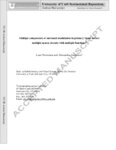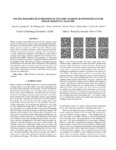|
|
Creator | Title | Description | Subject | Date |
| 101 |
 |
Zhang, Kang | Molecular and developmental characterization of the heat shock cognate 4 gene of Drosophila melanogaster | The Drosophila heat shock cognate gene 4 (hsc4), a member of the hsp70 gene family, encodes an abundant protein, hsc70, that is more similar to the constitutively expressed human protein than the Drosophila heat-inducible hsp70. Developmental expression revealed that hsc4 transcripts are enriched in... | Embryo, Nonmammalian; Molecular Sequence Data | 1990 |
| 102 |
 |
Baehr, Wolfgang; Rao, Narayanam V. | Molecular characterization of a third member of the guanylyl cyclase-activating protein subfamily | The mammalian retina contains at least two guanylyl cyclases (GC1 and GC2) and two guanylyl cyclase-activating proteins (GCAP1 and GCAP2). Here we present evidence of the presence of a new photoreceptor-specific GCAP, termed GCAP3, which is closely related to GCAP1. The sequence similarity of GCAP3 ... | Amino Acid Sequence; Cloning, Molecular; Gene Expression Regulation | 1999 |
| 103 |
 |
Baehr, Wolfgang | Molecular characterization of human and mouse photoreceptor guanylate cyclase-activating protein (GCAP) and chromosomal localization of the human gene | Guanylate cyclase-activating protein (GCAP) is a novel Ca(2+)-binding protein that stimulates synthesis of cGMP in photoreceptors. Molecular cloning of human and mouse GCAP cDNA revealed that the known mammalian GCAPs are more than 90% similar, consist of 201-205 amino acids, and contain three ident... | Amino Acid Sequence; Base Sequence; Cloning, Molecular | 1994 |
| 104 |
 |
Jones, Bryan W. | Molecular phenotyping of retinal ganglion cells | Classifying all of the ganglion cells in the mammalian retina has long been a goal of anatomists, physiologists, and cell biologists. The rabbit retinal ganglion cell layer was phenotyped using intrinsic small molecule signals (aspartate, glutamate, glycine, glutamine, GABA, and taurine) and glutama... | Aspartic Acid/metabolism; Image Cytometry/methods | 2002 |
| 105 |
 |
Baehr, Wolfgang | Mouse opsin. Gene structure and molecular basis of multiple transcripts | The single copy mouse opsin gene produces five major transcripts, varying in size from 1.7 to 5.1 kilobases. The mRNAs are present at levels that vary over 2 orders of magnitude and can be detected as early as postnatal day 1. Each of the transcripts is polyadenylated and can be identified in polyso... | Polyribosomes; Restriction Mapping; Sequence Homology, Nucleic Acid | 1990 |
| 106 |
 |
Angelucci, Alessandra | Multiple components of surround modulation in primary visual cortex: Multiple neural circuits with multiple functions? | The responses of neurons in primary visual cortex (V1) to stimulation of their receptive field (RF) are modulated by stimuli in the RF surround. This modulation is suppressive when the stimuli in the RF and surround are of similar orientation, but less suppressive or facilitatory when they are cross... | | 2014-01-01 |
| 107 |
 |
Baehr, Wolfgang; Frederick, Jeanne M.; Church-Kopish, Jill; Howes, Kimberly | Mutant rhodopsin transgene expression on a null background | PURPOSE. To study mechanisms leading to photoreceptor degeneration in mouse models for autosomal dominant retinitis pigmentosa (adRP) based on the rhodopsin P23H mutation. METHODS. Mice of a transgenic line expressing a rhodopsin triple mutant, V20G, P23H, and P27L (GHL), were mated with rhodopsin (... | Mutant Rhodopsin; Photoreceptor Degeneration; Autosomal Dominant Retinitis Pigmentosa; Rhodopsin | 2001-03 |
| 108 |
 |
Zhang, Kang; Yang, Zhenglin; Jiang, Li | Mutations in LRP5 or FZD4 underlie the common familial exudative vitreoretinopathy locus on chromosome 11q | Familial exudative vitreoretinopathy (FEVR) is an inherited blinding disorder of the retinal vascular system. Autosomal dominant FEVR is genetically heterogeneous, but its principal locus, EVR1, is on chromosome 11q13-q23. The gene encoding the Wnt receptor frizzled-4 (FZD4) was recently reported ... | Familial exudative vitreoretinopathy; FEVR; Inherited blinding disorders | 2004 |
| 109 |
 |
Normann, Richard A.; Maynard, Edwin M. | Neural interface for a cortical vision prosthesis | The development of a cortically based vision prosthesis has been hampered by a lack of basic experiments on phosphene psychophysics. This basic research has been hampered by the lack of a means to safely stimulate large numbers of cortical neurons. Recently, a number of laboratories have developed a... | Neuroprosthetics; Artificial Vision; Electrode Arrays; Multielectrode Recordings; Biocompatibility | 1999 |
| 110 |
 |
Normann, Richard A.; Kolb, Helga | Neural organization of the retina of the turtle Mauremys caspica: a light microscope and Golgi study | The organization of the retina of the turtle species Mauremys caspica, found in fresh water ponds of Israel, has been examined by light microscopical techniques including examination of fresh wholemount retina, one micron blue-stained vertical sections and Golgi-stained material. The anatomical find... | Turtle Retina; Photoreceptors; Golgi Technique; Amarcine Cells | 1988 |
| 111 |
 |
Digre, Kathleen B.; Skuster, Denise Z. | Neurologic conditions presenting as psychiatric disorders. | Understanding underlying neuroanatomic function helps physicians to localize defects and search for treatable neurologic conditions. Neurologic conditions such as Huntington's chorea, Wilson's disease, Gille de la Tourette syndrome, brain tumors, encephalitis and meningitis, neurodegenerative condit... | Psychiatric Diagnosis; Neurologic Disease | 1992-06-15 |
| 112 |
 |
Normann, Richard A.; Maynard, Edwin M. | Neuronal interactions improve cortical population coding of movement direction | Interactions among groups of neurons in primary motor cortex (MI) may convey information about motor behavior. We investigated the information carried by interactions in MI of macaque monkeys using a novel multielectrode array to record simultaneously from 12-16 neurons during an arm-reaching task. ... | Motor Cortex; Monkey; Population Coding; Movement | 1999 |
| 113 |
 |
Frederick, Jeanne M. | Neurotransmitter properties of the newborn human retina. | Human retinal tissue from a newborn was examined autoradiographically for the presence of highaffinity uptake and localization of the following putative neurotransmitters: dopamine, glycine, GAB A, aspartate, and glutamate. In addition, the dopamine content of this newborn retina was measured by ... | Newborn; Human Retina; Neurotransmitter Properties; Photoreceptors | 1983 |
| 114 |
 |
Zhang, Kang | New locus for autosomal dominant stargardt-like disease maps to chromosome 4 | Stargardt disease (STGD) is the most common hereditary macular dystrophy and is characterized by decreased central vision, atrophy of the macula and underlying retinal-pigment epithelium, and frequent presence of prominent flecks in the posterior pole of the retina. STGD is most commonly inherited a... | Haplotypes; Genetic Markers | 1999 |
| 115 |
 |
Baehr, Wolfgang | Noninvasive two-photon imaging reveals retinyl ester storage structures in the eye | Visual sensation in vertebrates is triggered when light strikes retinal photoreceptor cells causing photoisomerization of the rhodopsin chromophore 11-cis-retinal to all-trans-retinal. The regeneration of preillumination conditions of the photoreceptor cells requires formation of 11-cis-retinal in t... | Microscopy, Fluorescence; Visual Perception; Membrane Proteins | 2004 |
| 116 |
 |
Bernstein, Paul S.; Gellermann, Werner | Nonmydriatic fluorescence-based quantitative imaging of human macular pigment distributions. | We have developed a CCD-camera-based nonmydriatic instrument that detects fluorescence from retinal lipofuscin chromophores ("autofluorescence") as a means to indirectly quantify and spatially image the distribution of macular pigment (MP). The lipofuscin fluorescence intensity is reduced at all ret... | Cytology; Sensitivity and Specificity | 2006-10 |
| 117 |
 |
Digre, Kathleen B. | Not so benign intracranial hypertension. | Despite many controversies, intracranial hypertension due to use of doxycycline does occur. Practitioners prescribing the tetracyclic antibiotics should be aware of the syndrome of increased intracranial pressure, and pay particular attention to the ocular fundus for papilloedema. Appropriate referr... | Venous Occusion; Venous Hypertension; Tetracycline, Doxycycline; Minocycline | 2003-03-22 |
| 118 |
 |
Baehr, Wolfgang | Novel GCAP1 missense mutation (L151F) in a large family with autosomal dominant cone-rod dystrophy (adCORD) | PURPOSE: To elucidate the phenotypic and biochemical characteristics of a novel mutation associated with autosomal dominant cone-rod dystrophy (adCORD). METHODS: Twenty-three family members of a CORD pedigree underwent clinical examinations, including visual acuity tests, standardized full-field ERG... | Polymorphism, Single-Stranded Conformational; Guanylate Cyclase-Activating Proteins; DNA Mutational Analysis | 2005 |
| 119 |
 |
Baehr, Wolfgang | Novel mutation (I143NT) in guanylate cyclase-activating protein 1 (GCAP1) associated with autosomal dominant cone degeneration | PURPOSE: To identify pathogenic mutations in the guanylate cyclase-activating protein 1 (GCAP1) and GCAP2 genes and to characterize the biochemical effect of mutation on guanylate cyclase (GC) stimulation. METHODS: The GCAP1 and GCAP2 genes were screened by direct sequencing for mutations in 216 pat... | DNA Mutational Analysis; Mutation, Missense; Electroretinography | 2004 |
| 120 |
 |
Zhang, Kang | Novel mutation in the ELOVL4 gene causes autosomal dominant Stargardt-like macular dystrophy | PURPOSE. To conduct clinical and genetic studies in a European family with autosomal dominant Stargardt-like macular dystrophy (adSTGD-like MD) and to investigate the functional consequences of a novel ELOVL4 mutation | Macular dystrophy; ELOVL4 mutation; Genetics | 2004 |
| 121 |
 |
Kriesel, John D.; Spruance, Spotswood L.; Daynes, Raymond A. | Nucleic acid vaccine encoding gD2 protects mice from herpes simplex virus type 2 disease. | Nucleic acid vaccinations with plasmids pWW65, containing the sequence for herpes simplex type 2 (HSV-2) gD2, and pRSVnt, lacking the gD sequence, were studied. Groups of mice were immunized with pWW65 alone, pWW65 plus 1,25-dihydroxyvitamin-D3 (D3), or pRSVnt. Clinical disease (vaginitis), serum an... | Mice, Inbred BALB C; Plasmids; Viral Vaccines | 1996 |
| 122 |
 |
Jones, Bryan W. | Online parameter estimation in dynamic Markov Random Fields for image sequence analysis | Markov Random Fields (MRF) have proven to be extremely useful models for efficient and accurate image segmentation.Recent literature points to an increased effort towards incorporating useful priors (shape, geometry, context) in a MRF framework. However, topological priors, considered extremely cruc... | | 2012-01-01 |
| 123 |
 |
Normann, Richard A. | Oscillations in rod and horizontal cell membrane potential: evidence for feed-back to rods in the vertebrate retina | 1. Rods and horizontal cells were studied with intracellular recordings in the retina of the toad, Bufo marinus; 161 cells were from the eyecup preparation and thirty were from the isolated perfused retina. 2. Of these cells, 39% exhibited either transient or sustained oscillations of membrane poten... | Retina; Photoreceptors; Toads; Adaptation, Ocular | 1976 |
| 124 |
 |
Mamalis, Nick; Nilson, Christian D. | Outbreak of toxic anterior segment syndrome following cataract surgery associated with impurities in autoclave steam moisture. | BACKGROUND: Toxic anterior segment syndrome (TASS), a complication of cataract surgery, is a sterile inflammation of the anterior chamber of the eye. An outbreak of TASS was recognized at an outpatient surgical center and its affiliated hospital in December 2002. METHODS: Medical records of patients... | Toxic anterior segment syndrome; cataract surgery; autoclave steam moisture | 2006 |
| 125 |
 |
Olson, Randall J.; Pingree, Michael F.; Lundergan, Maureen K. | Penetrating keratoplasty for keratoconus: a long-term review of results and complications | PURPOSE: To study the long-term complications of penetrating keratoplasty (PKP) to evaluate current recommendations to patients with keratoconus. SETTING: John Moran Eye Center, University of Utah, Salt Lake City, Utah, USA. METHODS: Retrospective study of all PKP procedures for keratoconus performe... | Visual Acuity; Refraction, Ocular; Keratoconus; Astigmatism | 2000-07 |

























